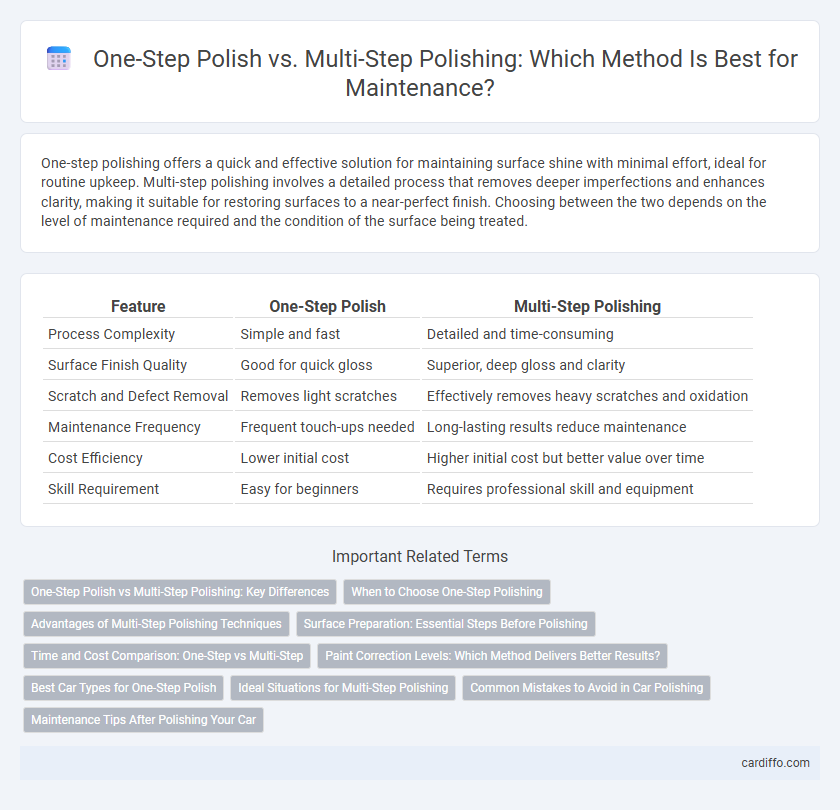One-step polishing offers a quick and effective solution for maintaining surface shine with minimal effort, ideal for routine upkeep. Multi-step polishing involves a detailed process that removes deeper imperfections and enhances clarity, making it suitable for restoring surfaces to a near-perfect finish. Choosing between the two depends on the level of maintenance required and the condition of the surface being treated.
Table of Comparison
| Feature | One-Step Polish | Multi-Step Polishing |
|---|---|---|
| Process Complexity | Simple and fast | Detailed and time-consuming |
| Surface Finish Quality | Good for quick gloss | Superior, deep gloss and clarity |
| Scratch and Defect Removal | Removes light scratches | Effectively removes heavy scratches and oxidation |
| Maintenance Frequency | Frequent touch-ups needed | Long-lasting results reduce maintenance |
| Cost Efficiency | Lower initial cost | Higher initial cost but better value over time |
| Skill Requirement | Easy for beginners | Requires professional skill and equipment |
One-Step Polish vs Multi-Step Polishing: Key Differences
One-step polish offers a quicker application by combining compounding, polishing, and finishing into a single process, making it ideal for light oxidation and minor surface imperfections. Multi-step polishing involves separate stages of compounding, polishing, and finishing, providing superior correction for deeper scratches, swirl marks, and oxidation by progressively refining the paint surface. Choosing between one-step polish and multi-step polishing depends on the extent of paint damage and desired finish quality.
When to Choose One-Step Polishing
One-step polishing is ideal for routine maintenance when surfaces have light to moderate wear, offering a fast and efficient solution to restore shine without aggressive abrasion. This method is suitable for harder materials such as sealed granite or quartz, where minimal surface correction is needed. Opt for one-step polishing to save time and reduce labor costs while maintaining an attractive finish on relatively well-preserved surfaces.
Advantages of Multi-Step Polishing Techniques
Multi-step polishing techniques enhance surface quality by progressively refining abrasiveness, resulting in a smoother, more uniform finish with reduced swirl marks and scratches. These methods extend the lifespan of materials by minimizing surface defects and improving corrosion resistance. Consistent application of multi-step polishing ensures superior gloss and durability compared to one-step polish processes.
Surface Preparation: Essential Steps Before Polishing
One-step polish simplifies surface preparation by combining cleaning, smoothing, and polishing in a single application, saving time and effort on minor imperfections. Multi-step polishing involves sequential use of compounds and pads to progressively refine the surface, essential for deeper scratches or oxidation, ensuring a flawless finish. Proper surface preparation in multi-step processes includes thorough washing, clay bar treatment, and defect inspection to maximize polishing effectiveness and durability.
Time and Cost Comparison: One-Step vs Multi-Step
One-step polishing significantly reduces maintenance time by combining cleaning and polishing into a single process, resulting in lower labor costs compared to multi-step polishing that requires separate phases for cleaning, polishing, and buffing. While multi-step polishing can offer more thorough surface refinement, it demands additional equipment and materials, increasing overall expenses and downtime. Businesses aiming to optimize operational efficiency often prefer one-step polishing for its balance of effectiveness and cost-saving benefits.
Paint Correction Levels: Which Method Delivers Better Results?
One-step polish offers a faster solution by removing light imperfections and enhancing gloss, ideal for minimal paint correction needs. Multi-step polishing provides deeper correction, effectively eliminating swirl marks, scratches, and oxidation through progressive abrasive levels. For superior paint correction results, multi-step polishing delivers a more refined and lasting finish compared to the one-step method.
Best Car Types for One-Step Polish
One-step polish is ideal for well-maintained vehicles with minimal paint imperfections, such as daily-driven sedans and newer SUVs, as it efficiently restores shine without aggressive abrasion. Cars with factory-clear coats, like many Japanese and European models, respond well to one-step polishing due to their relatively soft paint surfaces. This method suits owners seeking quick, effective maintenance without the complexity of multiple compound and polish stages.
Ideal Situations for Multi-Step Polishing
Multi-step polishing is ideal for surfaces with heavy oxidation, deep scratches, or significant imperfections that require progressive smoothing to restore clarity and finish. It allows for precise control over abrasive levels, minimizing the risk of damage while maximizing the surface's gloss and protection. This method is preferred in professional detailing and restoration where optimal results outweigh the time investment.
Common Mistakes to Avoid in Car Polishing
One-step polish is designed for light correction, while multi-step polishing targets deeper swirls and oxidation, making it crucial to match the method to the paint condition to avoid damaging the clear coat. Common mistakes include over-polishing with aggressive compounds, which can thin the paint, and skipping proper cleaning before polishing, leading to trapped abrasives that cause scratches. Using the wrong pad or excessive pressure during either method results in uneven finishes and potential burn spots on the vehicle's surface.
Maintenance Tips After Polishing Your Car
After polishing your car, maintaining the finish requires regular washing with pH-balanced car shampoo to prevent residue buildup and maintain the shine. Applying a high-quality sealant or wax enhances protection against UV rays and environmental contaminants, extending the lifespan of both one-step and multi-step polishing results. Inspect the surface periodically for minor scratches or swirl marks, addressing them promptly with spot treatments to preserve the polished appearance.
One-step polish vs multi-step polishing Infographic

 cardiffo.com
cardiffo.com